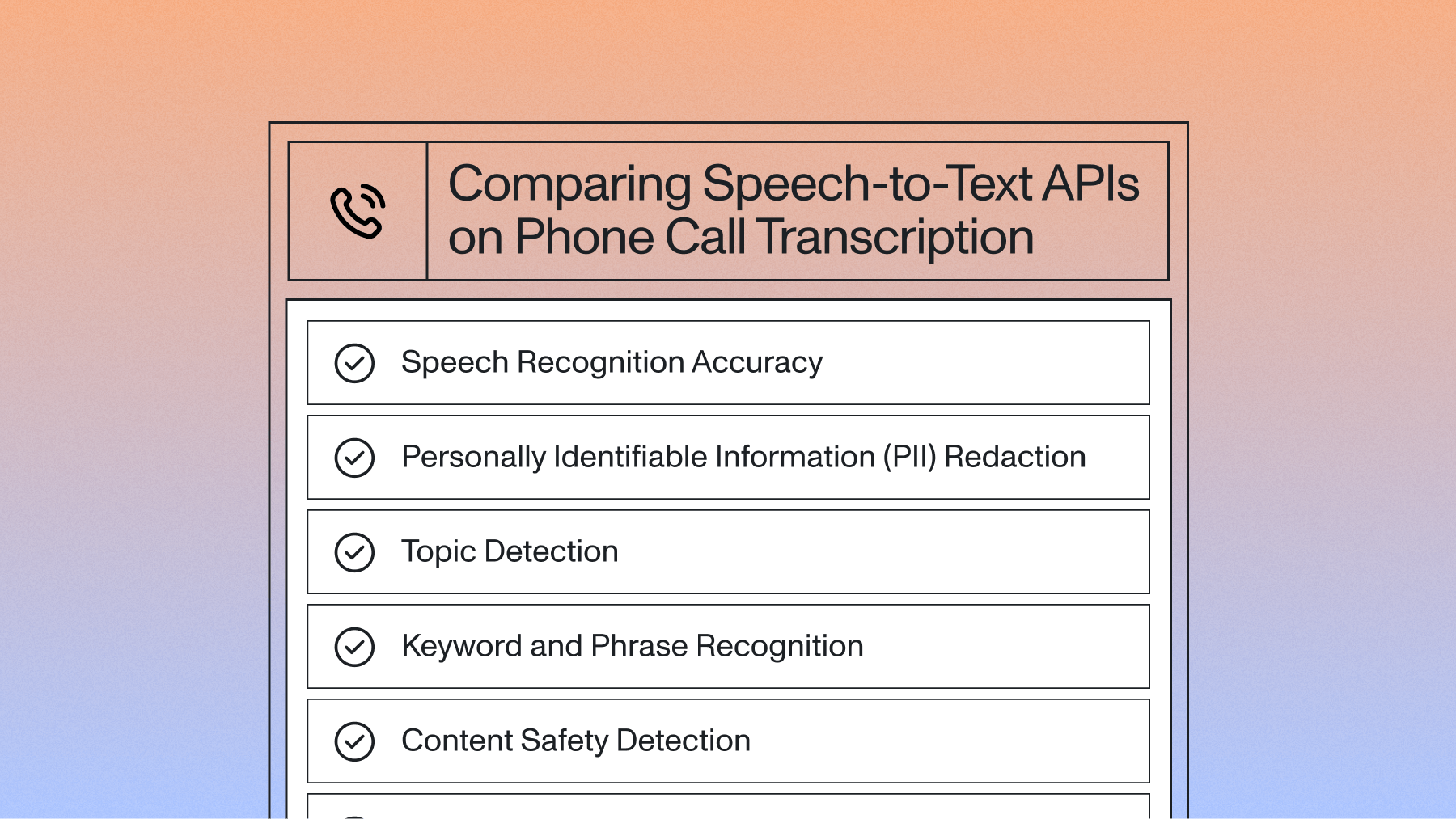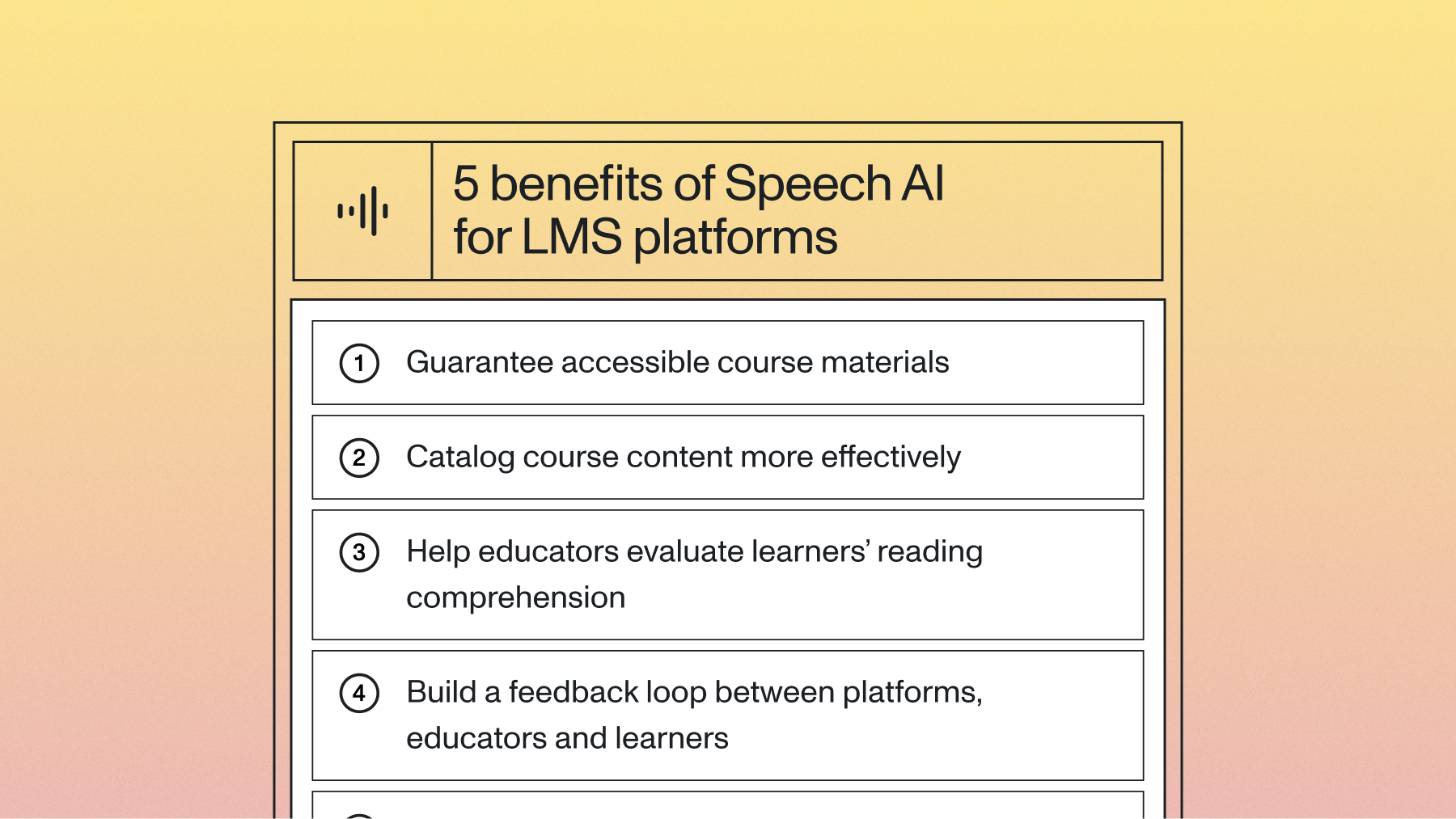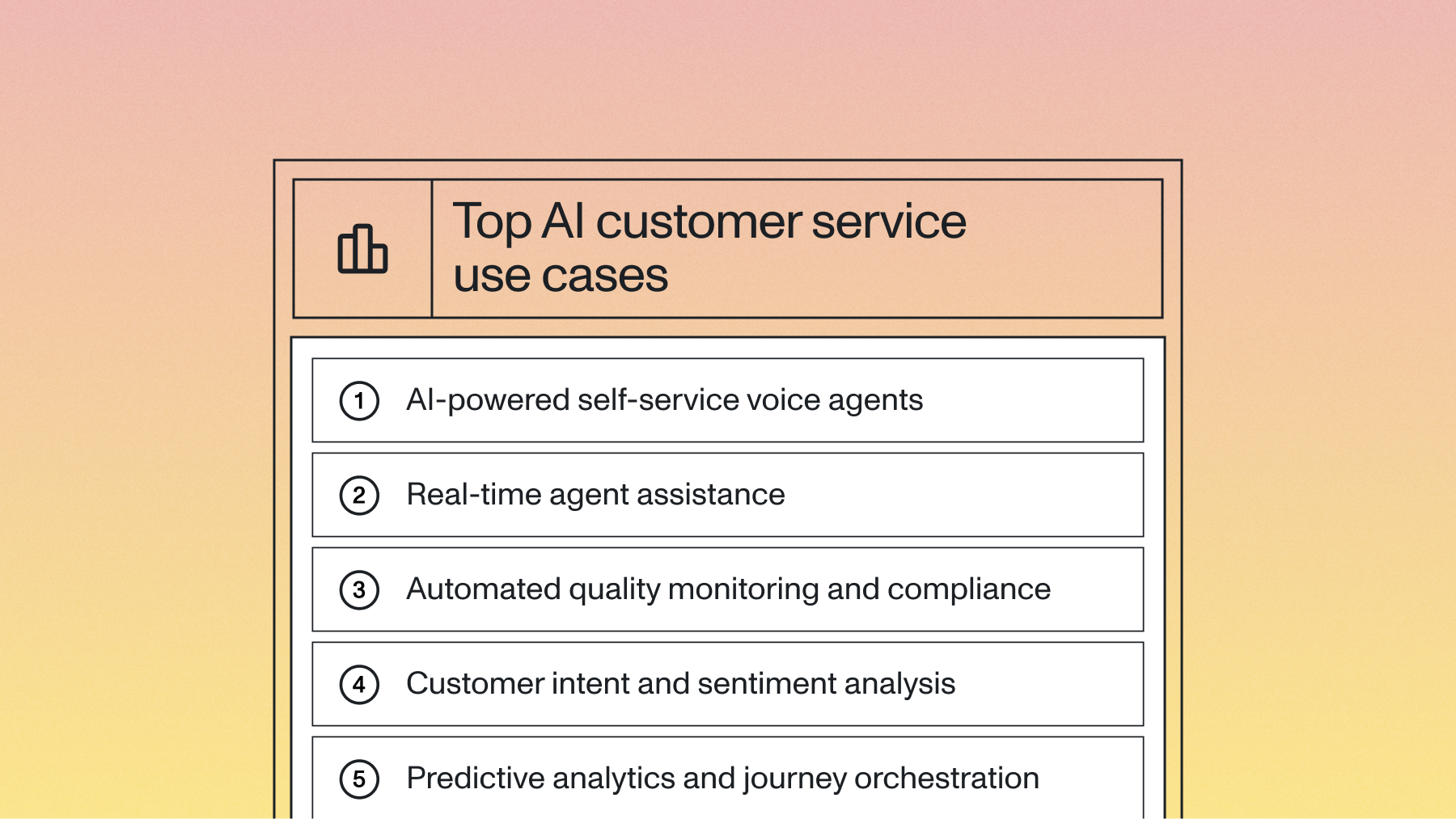8 Ways Automatic Speech Recognition Can Increase Efficiency For Your Business
Learn how to leverage speech AI to complete previously manual tasks in a fraction of the time.



Most businesses have no shortage of audio and video content. Consider the recorded calls from a call center, the videos of the sales team with potential clients, or the weekly podcast your marketing team produces. While this content offers a gold mine of data, this information often goes to the wayside. It would take weeks to filter and categorize all of the information to identify common issues or patterns.
Using Automatic Speech Recognition (also known as speech to text AI, speech AI, or ASR), companies can efficiently transcribe speech to text at scale, completing what used to be a laborious process in a fraction of the time. And that’s just a glimpse of what’s possible. By using Audio Intelligence, LLMs and frameworks, companies can build on top of ASR to create tools that categorize content, increase searchability, aid in podcast or video editing, and intelligently synthesize this information.
Discover how you can use Automatic Speech Recognition and AI models to build tools that increase efficiency within the following areas:
1. Content management
2. Video hosting and editing
3. Learning management software
4. Video and audio advertising
5. Live streaming
6. Podcast editing and hosting
7. Media monitoring
8. Meeting transcriptions and summarizations
1. Content management: organize and prioritize
After a video or audio file is transcribed using Automatic Speech Recognition, companies can apply additional AI models to the transcription text that can categorize and tag content. Using topic detection, which utilizes the IAB taxonomy to categorize transcripts into 698 topics, companies can build tools that map words and sentences under similar topics. This makes it easier to identify common themes, which can then be used to pull out descriptions for your content, identify solutions for recurring pain points on sales calls, or prioritize customer support calls.
For example, CallRail, a company that provides tracking and analytics for phone calls and web forms, automatically scores and categorizes key sections of customer calls by using AssemblyAI’s models. This allows CallRail’s customers to more easily identify high-priority calls and common customer challenges.
2. Video hosting and editing: increase searchability
In addition to video content categorization and tagging, companies can use speech recognition models to build tools that auto-generate subtitles and captions for pre-recorded videos. By including transcripts or captions for webinars, YouTube videos, or other video content, you can increase the searchability of your content while making it more accessible to viewers.
AI models can also be used to identify speakers and key phrases, allowing users to search for specific words, numbers, and phrases within transcripts. Through speaker identification and search, editing becomes a much simpler process to quickly find what sections you need to cut and polish your video content.
3. Learning management software (LMS): improve user experience
AI models make lectures and lessons more accessible to all by providing written transcriptions and captions for video content, but the benefits don’t stop there.
Through content categorization and tagging, users are able to more easily search for the content that’s relevant to them. For example, AssemblyAI’s Auto Chapters model outlines audio and video files into chapters as the topic of conversation evolves, while Text Summarization models automatically provide a summary for each chapter of content. This helps users of the LMS easily find the lessons and content that is most applicable to their needs while removing unnecessary, manual tasks from your team’s plate.
4. Video and audio advertising: simplify content moderation
For platforms that process video and audio advertising, it’s time-consuming to sort through the ad requests each month and moderate the content being displayed. By leveraging artificial intelligence models, companies can quickly detect sensitive content, such as hate speech, social issues, or drug usage, as well as competitive advertisements so that similar brands are not sharing the same ad space.
For companies that require content moderation of advertisements, AI models can identify the exact point when sensitive content was spoken within an audio or video file. With models like Assembly AI’s Content Moderation model, companies even receive a severity and confidence score for each identified topic so that your team knows what to prioritize.
Loop TV, for example, processes billions of ad requests each month. It now employs AssemblyAI’s Audio Intelligence APIs to ensure brand safety on the Loop TV platform, avoiding content mishaps that can ruin a brand’s integrity.
5. Live streaming: increase accessibility
Live streaming is an incredible feature for conferences, sporting events, and live webinars or workshops. But, live streaming is not the most accessible format, especially if you don’t offer live captioning. Fortunately, real-time speech recognition provides transcriptions within milliseconds. For your next conference keynote or company announcement, make your event more accessible with real-time transcription.
6. Podcasts: edit and host with ease
For businesses with a podcast, you know that the time it takes to edit is often longer than it takes to record the podcast. Automatic speech recognition allows you to transcribe the audio recording to better identify what needs to be edited from the podcast. From there, you can leverage AI models to extract audio intelligence and identify the speakers.
By recognizing speakers, also known as speaker diarization, you can seamlessly reference and cut the appropriate sections in your podcast files as well as create clips of specific sections for promotion and advertisements. Read more about speaker diarization here or check out our docs.
7. Media monitoring: keep a pulse on your brand
Through media monitoring, the practice of tracking and analyzing the mentions of your brand outside of your company, you’re able to understand how your brand is viewed by customers and the larger public. While individuals do not have the time or resources to evaluate all of the mentions of your brand across channels, AI is able to sort through all of this information in real-time and provide you with the overall perception of your brand.
By incorporating a sentiment analysis model, companies can create a tool that evaluates whether the mentions of your business are positive, negative, or neutral. This gives you a deeper understanding of the general sentiment around your brand while real-time content moderation flags references that need your immediate attention, such as sensitive content or a crisis.
8. Meetings: transcribe, summarize, analyze
One incredible way of increasing day-to-day efficiencies using AI models is to transcribe and summarize learnings from virtual meetings. With an AI model like Text Summarization, businesses can extract key insights from meeting recordings (or hundreds of recordings) as well as pull action items from these meetings.
By building a tool with Text Summarization, your business can:
- Help sales teams easily review pitches and make tweaks to improve the sales process
- Give product teams the ability to see what features or developments are missing from pitches that don’t close
- Improve documentation by reviewing the most common customer support calls
- Assist public relations teams by synthesizing interviews and pulling quotes
- Help hiring teams cut down on administrative tasks and quickly fill positions
Businesses can also use Large Language Model (LLM) frameworks like LLM gateway to complete previously manual tasks like automatically generating action items or gaining clarity around a specific concept from meeting recordings.
Automatic Speech Recognition coupled with LLM frameworks like LLM gateway offer time-saving methods that drive efficiency for your business and provide insights using the voice data you already have. Don’t let your data go to waste—put it to work.
Lorem ipsum dolor sit amet, consectetur adipiscing elit, sed do eiusmod tempor incididunt ut labore et dolore magna aliqua. Ut enim ad minim veniam, quis nostrud exercitation ullamco laboris nisi ut aliquip ex ea commodo consequat. Duis aute irure dolor in reprehenderit in voluptate velit esse cillum dolore eu fugiat nulla pariatur.







